Archive for ‘Planning’ Category
Paper Doll on Planning & Prioritizing for Leadership

You’re used to reading what I have to say about organizing and productivity in the pages of the Paper Doll blog. It might be easy to imagine me as some disembodied robot, typing away. But I am a real (and lively, and talkative) person, and I’ve been delighted to spend the early part of this summer getting to talk about my favorite topics with other experts for the benefit of people interested in guidance on these issues.
In fact, I’ve done four interviews over the past two months, three of which have been for podcasts, which I’ll tell you about later in the post. But today, I’d like to tell you about a really interesting (and FREEEEEE) opportunity for you to learn about planning, prioritizing, and leadership. (And remember, leadership isn’t just about being “in charge” at work. We lead in our homes, in our volunteer areas, and in our communities. Wouldn’t it be nice not to be overwhelmed there, too?)
I’d love for you to join me, along with a few of my beloved productivity colleagues (Frank Buck and Augusto Pinaud, about whom you heard oodles back in Paper Doll Picks: Organizing and Productivity Podcasts), and twenty other specialists for a FREE, 21-day, virtual event.
This event is for those of you who have a desire to accomplish more (of the right things) but have less stress, and to stop feeling stuck or frustrated because you’re not further along. (And since we’ve just come off a five-part series on toxic productivity, you know how that hamster wheel gets us spinning in circles, but not necessarily getting anywhere.)
The official name for this event has so many words in it, you’d think it was a Paper Doll blog post!
The Leader’s Asset: How To Increase Your Leadership Capacity & Reduce Overwhelm Through More Effective Planning & Prioritizing!
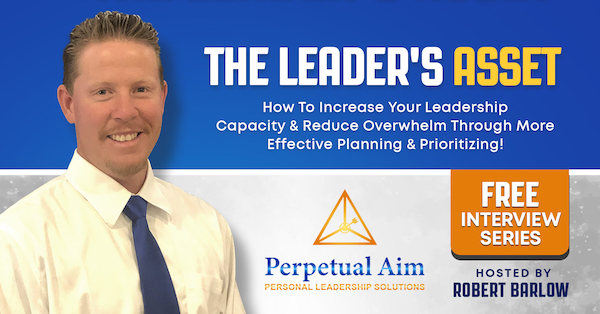
Before I forget, you can head over to my special link http://theleadersasset.com/JulieBestry to register. (This isn’t an affiliate link. I don’t get anything out of you registering except the joy of knowing I get dibs on saying I introduced you to this series. But as you’ll see, I’m pretty psyched about it.)
Each of us joined with The Leader’s Asset founder, Robert Barlow of Perpetual Aim (Personal Leadership Solutions), to record video interviews on subjects covering:
- How to plan and prioritize to reduce your overwhelm
- Ways to effectively beat procrastination
- How to accomplish more (of the right things) in less time
- Solutions to gain control over your email
- Tips, tools, and strategies to make planning and prioritizing more effective
- Dealing with distractions and keeping urgent tasks from derailing your focus
- And many more nuggets of wisdom and learning
These are not long, droning PowerPoint presentations. Instead, these are short, information-packed, conversational interviews with zero fluff. Every interview with Robert clocks in at about 20 minutes. (OK, you know I’m a talker, so mine is a few teensy minutes more!)
The point is that you will walk away from each interview with actionable strategies you can use right away and some newly-tweaked mindsets that will, as Robert says, TAKE YOU TO THE NEXT LEVEL!
So, would you (or your spouse, or your bestie, co-workers, and pals) like to hear from a diverse group of experts on how to be more successful leaders by really grasping the whole magic of planning and prioritizing?
How does it work? Once you register, you’ll get a welcome email, and then beginning Monday, July 18th, you’ll get an email each morning with a link to that day’s interview. Again, the 21-day series is free, but you’ll also have a chance to upgrade to a VIP package, with lifetime access to the recordings and some special opportunities Robert has in store.
So come on and register for The Leader’s Asset Interview Series.
Curious about who else is participating besides me, Frank, and Augusto? I don’t want to spoil any of Robert’s surprises, but I can give you a preview of some of the variety of talent he’s put together for this series, which includes:
- Bob Wendover has built a business helping people beat burnout, improve workplace problem solving skills, and develop critical thinking capacity.
- Oleg Konovalov is a global thought leader, author, business educator, consultant, and C-suite coach. He’s known as the DaVinci of Visionary Leadership, and uses his research to help entrepreneurs and managers identify their strategic needs in the terms of leadership.
- Shanda Miller is a leadership coach, trainer, and writer, and author of the book From Supervisor to Super Leader.
- Eva Medilek is a coach who teaches high performance success habits so her clients can leave behind their burnout, overwhelm, and exhaustion.
- Divya Parekh combines her biopharmaceutical career with experience as a coach, author, consultant, and speaker to help individuals become better leaders.
And that’s just scratching the surface. So I invite you to come play in The Leader’s Asset Interview Series sandbox with me, Robert Barlow, and these experts. Take 20 minutes a day to get some gems on how to improve your planning and prioritizing so you can work smarter (and healthier), lead better, and enjoy it all more.
UPDATE: The schedule has been announced, and my interview will go live on Wednesday, July 27, 2022! (Frank’s is Tuesday July 19th; Augusto’s is August 6th. But register to find out the whole schedule and start watching on Monday, July 18th!)
DIDN’T I SAY SOMETHING ABOUT PODCASTS?
I did!
As I mentioned at the top, I’ve been delighted to have been interviewed for three podcasts recently. In my own way, I’ve been working on different aspects of “leadership” in terms of bringing productivity and organizing to a wider audience, beyond my Paper Doll family, clients, and speaking audiences.
I’ve written recently about how I’ve just recertified as a Certified Evernote Expert (formerly Evernote Certified Consultant). In the next month or so (schedule: TBA), I’m excited that I’ll be a guest of the fabulous Ray Sidney-Smith on his new season of the Getting More Done with Evernote podcast. Ray always asks insightful questions and our mutual geeking out over Evernote will make you feel like you were in the room with us.

Toward the end of the summer, I am agog to report that I’ll be a guest on The NAPO Stand Out Podcast with the savvy and chic Clare Kumar! We had an amazing and free-wheeling conversation about some of my favorite organizing topics!

And bringing this all full circle, because Dr. Frank Buck was the one who introduced me to Robert Barlow for the interview series, I was recently on an episode of Frank Buck: Productivity for Total Control & Peace of Mind. He even named the episode “Julie Bestry: Don’t Apologize…Organize!” and you know how I love that!

Listen to the podcast at the show link or via Apple Podcasts, Spotify, or wherever you like to get your podcast mojo going, and lookie, the YouTube video is embedded below. The magic of the internet! (But hey, if you enjoy what we have to say, please click through to YouTube and leave a comment so Frank can feel the love, too!)
So, it may be the lazy, hazy days of summer, but I’m trying to keep you entertained and informed on all things about organizing and productivity.
Oh, and if you sign up for The Leader’s Asset Interview Series, please let me know (so I can do a happy dance), and feel free to come back to this post and let me know any gems you learn from the interviews, whether mine or from one of the other experts.
Happy summer!
Review & Renew for 2022: Resolutions, Goals, and Words of the Year

Snuggled in this week, tucked away between two major holidays, it’s tempting to rush to end the year with some sense of completion on those unfinished tasks. As much as we’d like to be mindfully in the present, we’re zipping along, trying to impose control in an era when there’s very little control to be had.
So today, I propose you take a breather. Bask in the quiet glow before we rush headlong into the future. Take time to do a little review of the past year so you can feel renewed, and if not in control, at least in awareness, for 2022.
TAKE A BACKWARD GLANCE
The best way to grow is to built on one’s successes. Grab a cup of cocoa (or whatever makes you feel alert but cozy) and settle in someplace comfy.
Pull out your calendar, whether it’s digital or paper bound, and start taking note of your successes, achievements, and delights. Personally, I think it’s best to keep a running list on paper (I mean, I am Paper Doll, after all), but if you prefer a spreadsheet, Word doc, or a note in Evernote, by all means, go with what feels comfy.
Look Beyond the Obvious
You can definitely list big accolades, awards, or milestones. Sure, mark down when you hit your revenue goal or finished that marathon. But look at those subtle successes, too.
What did you stick with, even when it was hard? Success isn’t always marked by what you attain, but how you persevere!
What did you try, even though it was out of your comfort zone? Succeeding at what you’re good at is worthy of pride, but stepping up to do something scary but potentially rewarding? That’s magical. (For more on that, check out my Sara Skillen’s Organizing and Big Scary Goals: Working With Discomfort and Doubt To Create Real Life Order.)
What surprisingly good things occurred that you had never even thought to imagine in the first place?
What dreams came true? Where did you decide to make new dreams when the old ones proved untenable (due to life or world circumstances)?
Janet Barclay’s excellent Set Your Compass to Reach Your Goals for the New Year introduced me to the free, downloadable YearCompass, an international marvel. Even if you get nothing else from today’s post, I encourage you to download this fillable, printable PDF and explore the questions. Examine your past year and get guidance for going forward.
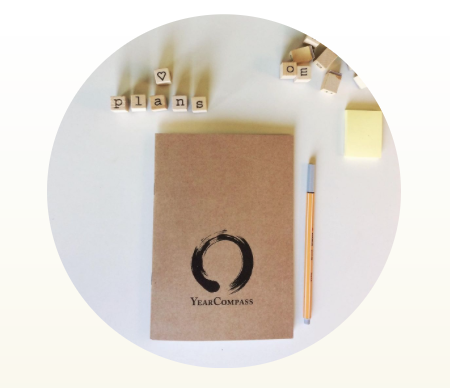
I’m working my way through the digital version now, and it’s providing more insight than I’ve received from any prior annual review.
If you prefer an even deeper dive (and are willing to use up lots of Post-its®), try doing a life audit, examining the past, present, and future of your life. Or go shallower, cut to the chase, and stick to Apartment Therapy’s 6 Smart Questions to Ask Yourself at the End of the Year.
Not everyone can weave a tapestry of the past year out of the blocks of a calendar, so this is just a start. If you journal, flip through the pages to look for highlights, and recognize that bad days are actually achievements. You got through them and made it through the other side. (You’re here to read this, right?)
Surf through your social media posts. You may be surprised by what you find on LinkedIn or Facebook (or, yes, TikTok or Instagram). Look for a sense of all the big and little ways you did your thing, or helped others do their things! In particular, look at places where you were tagged for shoutouts and gratitude. There are lots of people always touting having gratitude, but sometimes it’s nice to notice and remember when you did something worthy of someone else’s gratitude or kudos.
Ah, kudos! Speaking of which, definitely check your Success Folder! Don’t have one? Create one! Actually, create two.
Have a digital success folder where you put emails that praise or thank you, or otherwise give you warm fuzzies. While you may get fewer and fewer things by mail, have a paper folder for collecting such tangible high-fives. On days where you are down on yourself, feel under-appreciated, or are disappointed, pulling out something that reminds you that “good stuff happens” and that you’re part of that chain of events is going to lift your spirits.
Engage With Your Village
Raising a child isn’t the only thing that takes a village; count on others to help lift your spirits and give you insight.
Talk to your people. We’re not always good at keeping formal records of our successes, but our friends and loved ones automatically catalog the snazzy things about us. Once, a friend was entering the workforce for the first time in decades, and was bemoaning the fact that she had no marketable skills. But because I’d known her (just about) forever, I was able to recite everything from events she’d run as a volunteer coordinator to the time she caught a PTA high muckety-muck embezzling! She sure-as-heck had marketable skills, but couldn’t immediately see them in herself, let alone recognize her own magnificence.
Want to increase the magic? Recognize your own successes, but also pay attention to your friends’ and colleagues’ achievements. Share their blog posts on your social platforms instead of just clicking “like.” Promote their professional highlights. And send them emails and even write to them the old-fashioned way so they have something to put in their own Success Folders!
MOVING FORWARD: TRIED AND TRUE FOR ’22
Armed with insight into what we achieved (and what we wish we had tried) in the prior year, we can approach the new year. First, we’ll look at the classic approaches, but we’ll also examine some exciting new ways to support our dreams as we move forward into 2022, even if it’s about to be “COVID’s junior year.”
Resolve to Evolve
In general, New Year’s resolutions come in two flavors, either positive or negative.
With positive resolutions, we say we’re going to proactively do something. Maybe we’ll do Couch-to-5K or learn a language. For negative resolutions, we plan to eliminate some aspect of our lives that we know is dragging us down, so we vow to go on a diet or stop hate-watching The Bachelorette.
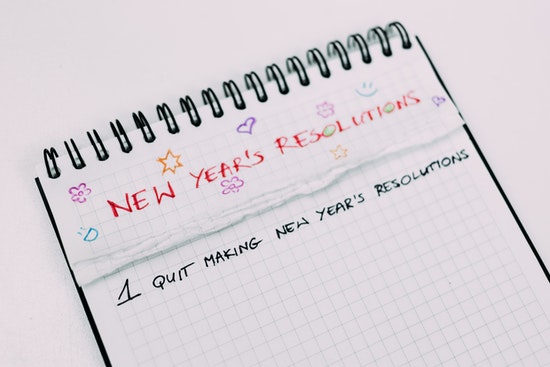
Photo by freestocks.org from Pexels
Resolutions date back many, many centuries. Four thousand years ago, the Babylonians promised the gods they would return borrowed objects and repay outstanding debts. (If only the Babylonians had had professional organizers to help them declutter and locate the borrowed stuff and couch cushion money.)
The Romans promised their two-faced god Janus, who looked simultaneously backward and to the future, that they’d be good in the year to come. And for several hundred years, Christian watch night services have included traditions of reflecting on the prior year and making resolutions for the one to come.
In the United States, resolution-making continues to increase; up to 40% of the population makes a New Year’s resolution. On the up-side, these resolutions help us start the new year in a motivated, positive way – right when the weather, the amount of sunlight, our bank balances, and our moods are at an annual low-ebb. December 31st is when we feel our age and recognize the passing of another year of unfulfilled potential; resolutions rev our engines.
On the down-side, the vast majority of people abandon their resolutions before February. Resolutions fizzle for three reasons:
- our real lives get in the way (year after year after year)
- our resolutions may be things we’re supposed to do, but aren’t passionate about
- we haven’t identified working strategies for achieving our resolutions
So, if you are going to make a resolution, make sure you’re picking things that excite and challenge you, but also figure out how to eliminate the past obstacles and ease your path.
For inspiration on developing new or different resolutions, consider some of the following:
Good Housekeeping‘s 60 Achievable New Year’s Resolutions for Healthier and Happier Living 2022 has less all-encompassing, more bit-sized resolutions, like “Prioritize age-appropriate health screenings,” “eat more vegetables,” and “listen to novels while you work out.
The Pioneer Woman has 40 New Year’s Resolution Ideas to Start 2022 Right, with some fun, sociable ideas like “give more compliments,” “send more cards,” and “make time to spend with family and friends.”
And Antimaximalist’s whopping 67 New Year’s Resolutions for 2022 prioritizes hopeful notions like, “Don’t settle for less than you deserve” and “Be less afraid of making mistakes.”
You can resolve to do things that are fun, too. Gretchen Rubin made a list of 21 things she wanted to do in 2021:
Here’s my 21 for 2021 list. I got a fair number of things crossed off my list. Now I’m writing my 22 for 2022 list—and deciding what items to carry over from 2021. pic.twitter.com/KmdMXUBAPu
— Gretchen Rubin (@gretchenrubin) December 21, 2021
and has a PDF to help you track your 22 in ’22.
Embrace Good Goals and Happy Habits
So, how can you supercharge your resolutions? Maybe stop thinking of them as big, sparkly things you resolve to do (with the unspoken societal expectation that it’ll all fall through), and consider the less flashy younger siblings of resolutions, ye old goals and habits.
Think of goals as providing the big-picture framework, the big city markers on the map; habits are the turn-by-turn directions to get you where you want to go.
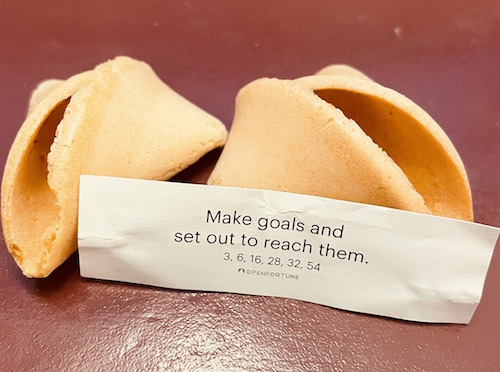
SMART goals are popular because they identify where resolutions and plans often fail.
- Specific (What are you going to do? Use action verbs! Where and when are you going to put these efforts into effect? With whose help or partnership will you get there?)
- Measurable (What metrics will you use to show you’ve done what you said you’d do? How many miles per day? How many lessons per week? How many blocks of time for achieving specific tasks?)
- Achievable (Is this a practical goal? Is it realistic?)
- Relevant (Does this goal make sense for your life, family, or business?)
- Time-based (When will you start? When will you perform the action? When will you repeat it? When will you finish? Remember, “Someday” is not a day on the calendar!)
And Paper Doll readers know that I prefer SMARTY goals, where that Y reflects the idea that these are goals that are meaningful to YOU, not your mother-in-law, boss, or favorite Instagram influencer.
I prefer SMARTY goals, where that Y reflects the idea that these are goals that are meaningful to YOU, not your mother-in-law, boss, or favorite Instagram influencer. Share on XWhether you want to lose weight, pay off debt, find a significant other, or grow your business, the goal can’t just be a vague “what I want” without any guideposts. Make sure your goals spell out what you’re going to do, how you’re going to do it, and how you’re going to measure your success.
So, if your goals set the rules and create the game plan, habits are how you get to the finish line.
If your goal is to get to work on time every day, but you often find yourself searching the house for your keys, wallet, phone, and charger, then you’ll want to develop a habit of assigning a “home” and always putting those items in the home upon returning to your house, before you even take off your shoes. If your goal is to be prepared at tax time, then your habits involve doing weekly record-keeping and filing, and not waiting until April 12th to get started.
Habits are your settled or repeated tendencies. Sure, bad habits become second nature, making them hard to break, but good habits are hard to break, too! So, if you can get in the habit of repeating positive, life-affirming tasks, you stand a much better chance of achieving your goals.
I recommend a few superior books for understanding how habits work, and how you can put them to use in your life. Both are becoming modern classics.
20+ Sites to Organize Your Holiday Dining, Shopping & More

Most of the time, when we talk about being organized and productive, we’re discussing reducing the non-essentials — whether those are duplicate or no-longer-necessary items, tasks that don’t fit our values or our goals, or habits that don’t get us where we want to end up.
But sometimes, and at the risk of seeming very much like that “You Won’t Believe How Much Time You’ll Save With These Organizing Secrets” clickbait, all we need is a little edge to make something a teeny bit easier. So, today’s post serves up a Thanksgiving smörgåsbord of web sites and apps to help you accomplish making your holiday life run more smoothly, whether you’re headed over the river and through the woods or staying put while everyone takes the I-90 or the red-eye to get to you.
And even if you’re planning to stay safely snuggled, avoiding the Thanksgiving hubbub again this year for safety, consider bookmarking these tips for future holiday seasons.
NIFTY SITES TO SAVE YOU FROM COOKING CONUNDRUMS

Still Tasty — Before you get started on holiday cooking, you’re going to need to take stock of your kitchen and check your pantry inventory against the recipes you plan to use. Sometimes you have an ingredient, but you’re just not quite sure whether it is up to snuff. Is it going to make your dessert dazzling or require a trip to the emergency room?
I don’t cook, but people who do always tell me that if an herb or spice has no scent anymore, it’s not going to deliver much to your meal. That makes sense. And obviously, anything that comes with an expiration date (as opposed to a more vague “best if used by” date) should be sent on its way. But what about everything else?
For example, I was recently on a web site where the community gives a lot of great advice, and someone posted, “I just realized I forgot to put the soy sauce back in the fridge last night. Do I have to throw it out.” Readers, I was gobsmacked. In all my <mumble mumble> years, I’ve never refrigerated soy sauce! So that sent me running to Still Tasty to find out if I’d been risking self-poisoning with every take-out sushi or Kung Pao dinner! (It turns out, I was okeydokey.)
To keep from wasting money by throwing out ingredients are still good (and maintaining the health of your family and friends), visit Still Tasty to figure out whether you should keep or toss an ingredient, ask questions about storage and expiration dates, and get the low-down on how to deal with food during or after a power outage. There are even tips on which foods you can bring through airport security (in case you’re sending folks home with leftovers) — and lots (and lots) of posts about turkey. Speaking of which…

Butterbull Turkey Talk Hotline — This year marks the 40th anniversary of the hotline at which more than fifty professionally trained turkey experts answer turkey-related questions (in English and Spanish) every holiday season, responding to 100,000+ questions for many thousands of North American households. Thaw, brine, stuff, roast, spatchcock, deep fry, grill, or carve, if you’ve got a Q, they’ve got a gobble-gobble A.
And it’s not just a phone hotline anymore. You can get answers to your turkey queries via multiple methods, including:
- Telephone — at 1-800-BUTTERBALL (1-800-288-8372)
- Text — at 844-877-3456
- Email or online chat via their contact page
- Amazon Alexa (but sadly, not Siri) — visit this page and scroll down to learn how
- And if you don’t mind other people knowing what your question is, you can ask via Facebook, Instagram, and TikTok! (Now I want a mash-up of Butterball questions and sea shanties!)
And because you know Paper Doll is all about pop culture references, I dare you to watch this classic Butterball-related clip from The West Wing and not giggle.
All these years, and I’m still not sure this wasn’t a PSA to make sure none of NBC’s viewers got salmonella.

Punchfork — Maybe your family cooks all of the same favorites year after year after year and that’s fine by you. But perhaps this is your first holiday season on your own, cooking Friendsgiving. Or maybe you and your sweetie-pie want to create new traditions that don’t include pecan pie. Sure, you could troll all the cookbooks and cooking blogs.
Or you could visit Punchfork. They gather the newest recipes from top-rated food sites and blogs and display them Pinterest-style so you can look at the mouth-watering photos and browse, seeing the finished product, the blog/site name, the community rating (based on how often it has been shared on social media), and how recently the recipe was posted.
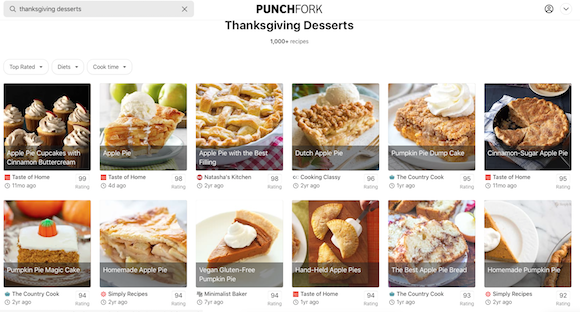
Sign up for free, and they start you off with a Favorites dashboard to which you can add recipes by clicking (again, Pinterest-style). Punchfork is available via your browser or as an iOS app.
The site is updated daily, and you can browse by ingredient name or use their natural-language search engine to find whatever you’re craving. I started researching this post late at night while craving chocolate, and was delighted to find twenty different recipes for Nanaimo bars!

If someone’s following a particular diet (vegetarian, vegan, paleo, gluten-free, etc.), there’s a search option. You can even search by excluded ingredients, in case someone has an allergy, sensitivity, or ick factor. (For example, Paper Doll hates cauliflower and gravy.)
And once the holidays are over and you’ve hoovered up every remaining leftover, you can just randomly type the ingredients you do still have available, and it’ll find you a recipe that will work.
Next, we have a little controversy.

Just the Recipe — With Just the Recipe, you can copy and paste any URL from anywhere on the web and it’ll give you (you guessed it) just the recipe. Not the blogger’s tale of the recipe’s history, not a request to join an email list, no ads, and no pop-ups. Just the recipe (including ingredients). You don’t even have to go to the website; you can just right-click (or control-click on a Mac) to copy a link directly from Google. (Hence the controversy, as you’ll see.)
Let’s say I want the Love and Lemons blog’s “Best Stuffing Recipe.” Let’s also say I’m in a super rush and can’t be bothered to scroll down the page to read the text and look at the photos that come before the recipe. I can paste it into Just the Recipe and it will spit out a clean, organized, ready-to-print page with just the ingredient list, the instructions, a small photo of the finished result, and a link back to the original. (This last part is important.)
Just the Recipe is a free browser-based site, though they’d like you to consider a $2/month premium version (for which there’s a 14-day free trial).
So why is this controversial? Apparently, there are a lot of people are out there who feel strongly that they don’t want to read carefully crafted food writing. They don’t care about the blogger’s grandmother, who carried the secret family recipe for borscht, scribbled in her own mother’s writing and tucked into her bosom as she escaped the old country. They just want ingredients, measurements, and steps.
I’m not fussing about the people who don’t care and scroll past the lovely stories. I get it. We’re all in a hurry these days. I’m talking about the people who are ANGRY AND VOCAL that food bloggers are writing anything but the actual recipes. (How vocal? Type “I just want the recipe” into a search engine and you get lots of profanity-laden posts, articles, web sites and app,s filled with anger about having to be subjected to non-recipe paragraphs. I imagine these people snapping impatiently at Grandma when she tells a story, shouting, “Get to the point!”)
The thing is, bloggers take time and effort to craft their blogs. (I know I do.) Some of these bloggers (including food bloggers) want to recoup the cost of ingredients for testing recipes, hosting sites, and tech support, and so they run advertising on their sites. (I don’t, but I still respect bloggers who do.)
And this content, whether it’s an essay about the blogger’s family or the history of the recipe or explanations of different ethnicities’ approaches to similar types of food, all serve to improve what’s called search engine optimization. It’s the thing that makes Google tell you about that recipe on the first search page and not the 57th. It’s brings people to a page.
So, it’s understandably controversial that there are sites (like Just the Recipe, Copy Me That, and others) that take this lovingly created content and strip everything that is a) meaningful to the creator and b) gives them a chance to generate money and especially c) gives other sites a chance to make money off the originator’s content.
My opinion? Not cool, dude. And I’m not the only one.
If you’re annoyed by scrolling to get to the recipe on personal food blogs you can:
– use cookbooks
– use one of the many, many recipe websites that don’t preface their recipes with stories
– just deal with 3 seconds of annoyance for your free recipe and move on with your life— Helen Rosner (@hels) February 17, 2020
Last spring, I learned about the hubbub from an article in Eater called, This Is What Happens When Tech Bros Attempt to ‘Fix’ Online Recipes. (Short answer, the Recipeasly shut down within weeks of being announced because they also realized what they were doing wasn’t cool.)
So, I encourage you to at least respect food bloggers enough to actually go to their pages. If you don’t want to click on the ads, I feel you. If you don’t want to read the content — and are willing to risk missing cautionary tales about food prep pitfalls, as well as narrative flavor — you do you, boo! But respect the bloggers enough to go to their pages, give their sites the “hits” for their posts, and maybe don’t complain.
(Don’t worry, I know none of Paper Doll‘s loyal readers would ever be such meanies. This is for those future readers who land here from a search about only wanting recipes.)
I was hoping to find you a website that provided timers and assistance for getting all of your Thanksgiving (or other holiday meals) cooked and ready at the same time. I was certain I’d find a link that would help you figure out how to enter the prep and cooking time for each menu item and then get step-by-step instructions for what to do when.
If there is such an app, I didn’t find it. If there isn’t, and you know a good programmer, consider this idea my gift to you. I did find the following articles, though:
How to Cook Thanksgiving With (Gasp!) One Oven
When You Should Start Cooking Every Dish For Thanksgiving
Here’s Exactly When To Cook Every Dish For Thanksgiving Dinner
And remember, your cell phone will let you set oodles of timers. Set one for every single item you put in the oven and label each timer (it just takes a second) with which food and what you’re supposed to be doing, whether that’s taking it out of the oven or flipping it over, or adding a glaze.
Omnicalculator does have a bunch of online calculators to make your cooking experience easier and more organized, from a Thanksgiving calculator that tells you how much (in pounds or pieces or gallons) of holiday food/beverages you’ll need to a turkey defrosting time calculator and so much more.
SITES TO EASE YOUR HOLIDAY SHOPPING EXPERIENCE
Obviously, as a professional organizer, I want to discourage you from shopping willynilly for things neither you nor your recipients need. I urge you to stay home on Black Friday (to stay safe — we are still in a pandemic, after all) and if you must shop, do it with a list and whenever possible, online.
There are several extensions you can add to your browsers to notify you if a retailer’s site you visit has a discount available.

My favorite is Rakuten, formerly Ebates (and formerly easier to pronounce). You can go directly to their site and then click through a retailer’s links. Doing so will give you a cookie (though not the kind with chocolate chips), and not only will you get a discount, but you’ll earn cash back. But even easier is to just add the little extension to your browser, and it’ll do all the work for you.
Similar sites include Capital One Shopping (formerly WikiBuy) and Honey.

Another site I use often is Retail Me Not. Let’s say you’re shopping at Kohl’s. (OK, let’s say I am, because it’s the only non-grocery, non-Amazon place I’ve shopped for the last 18 months.) Type the name of the retailer into the search box and you’ll see a wide variety of discount codes for different types of purchases at any given retailer. (I’ve found discounts for my web site’s domain registrar, restaurants, clothing stores, and sometimes even Amazon.)

CamelCamelCamel.com — Speaking of Amazon (and I know that between Black Friday and Cyber Monday, many of you will be), this dromedary-themed site is a free Amazon price tracker. Type in keywords for a product you want, or paste the Amazon URL for something you’re thinking about buying. (There’s also a Camelizer browser extension.)
Last week, my friend bought an iRobot 240 Braava Rob Mop, a mopping cousin of a Roomba.
Back-to-School Solutions for the Space-Time Continuum
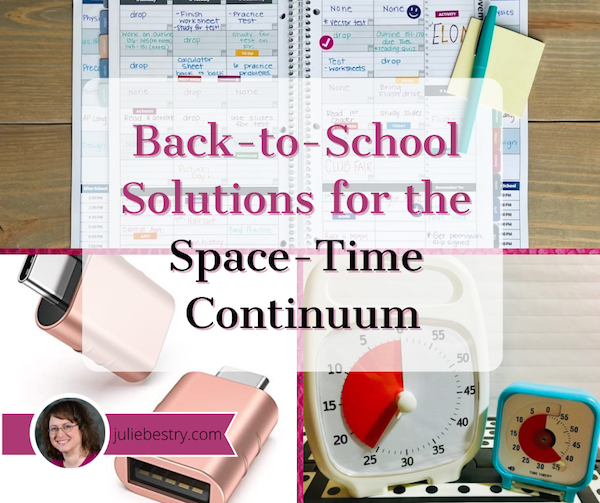
According to the Einstein page at Stanford University covering questions about Special and General Relativity:
This new reality was that space and time, as physical constructs, have to be combined into a new mathematical/physical entity called ‘space-time’, because the equations of relativity show that both the space and time coordinates of any event must get mixed together by the mathematics, in order to accurately describe what we see. Because space consists of 3 dimensions, and time is 1-dimensional, space-time must, therefore, be a 4-dimensional object. It is believed to be a ‘continuum’ because so far as we know, there are no missing points in space or instants in time, and both can be subdivided without any apparent limit in size or duration. So, physicists now routinely consider our world to be embedded in this 4-dimensional Space-Time continuum, and all events, places, moments in history, actions and so on are described in terms of their location in Space-Time.
Whew. That’s a lot. But I’ve got good news. This won’t be on the test! (We’ll leave it to the physics majors.)
But as a professional organizer, I often have to solve problems that involve time (and the management of tasks) and space (and the excising of clutter and the rearranging of the molecules of what remains). So, in this second week of looking at solutions that help our students go back to school, I’m sharing two products I praise often for handling the “time” part of the equation, and a few new delights for the space aspect.
TIME AND RELATIVITY
Getting firmly back onto “clock time” is key to the back-to-school process, and not just for little kids. Parents, teachers, and college students are just as much in need of time management support as little ones.
Getting control over the clock, especially after the lazy, hazy, crazy days of summer (and whatever these last 18 months have been) means really having a sense of time as it passes. Getting the “feel” of how long a quarter hour or ninety minutes really is can be hard, not just for kids, but for people with ADHD and various executive function disorders, and for any of us who’ve had a “flexible” relationship with time over this recent while.
It’s not just kids (or adults working in loosey-goosey fields) who have trouble with time. I’ve worked with engineers and scientists — professionals for whom precision is essential — on their productivity skills. We’ve started with an exercise where I tell them to begin a task we’ve discussed, and I will stop them after they’ve worked for eight minutes. I’ve seen two things happen.
When doing administrative work, like expense reports or employee reviews, these clients struggle. 90% of them have looked up at me early, insisting that surely it’s been eight minutes already. For about a third of those, they are certain at least that much time has passed before even the five-minute mark! They may as well be kicking the back of my seat and whining, “Are we there yet?”
In contrast, when these same clients are set free to work on their passion projects, to delve into whatever science-y, engineering-y thing they love (think: the Professor from Gilligan’s Island), they are often shocked when I call, “Time!” Sometimes, in just eight minutes, they’ve forgotten I was even there! (I try not to be offended by this.)
I guess Einstein was really right about time being relative, eh?
When you’re not “in flow,” when you’re focused on the time but not enthusiastic about the task, time passes slowly. If you don’t get into the flow state, into the groove, you’re constantly checking on the time and not embracing the task with your whole heart and mind, a recipe for dissatisfaction and unfinished work.
Or, you find ways to self-soothe, to do anything but what you’re supposed to, and you get into a flow state but doing the wrong thing. An analog clock, one that shows you the time as it passes, can be a comfort, to assure your “monkey mind” that you won’t be forced to do something boring and distasteful forever. The clock makes time a concrete concept; if you can see that you only have to do your workout routine for 20 minutes, your brain will back off of the obsession with how long it’s taking to do those downward-facing dogs or lunges or whatever.
Conversely, if you are in flow (on work or homework and hopefully not scrolling through social media), it can be hard to effectively transition from what you’re doing now to what you’re supposed to be doing next. Again, an analog clock with a gentle alarm can help you do this.
Also, friend-of-the-blog Dr. Melissa Gratias has a great post, “What is a “Task Transition” and How Can It Make Me More Productive?” on this very topic, and while the advice is geared for grownups, you can modify the instructions to help students get better at transitioning between projects.
For more on flow, check out the “Sidebar on Flow and the Unpronounceable Mihaly Csikszentmihalyi” in my post from last March, Flow and Faux (Accountability): Productivity, Focus, and Alex Trebek or watch Csikszentmihalyi’s superb TEDTalk, below.
Longtime readers know how much my profession loves one particular kind of analog clock/timer.
Time Timer
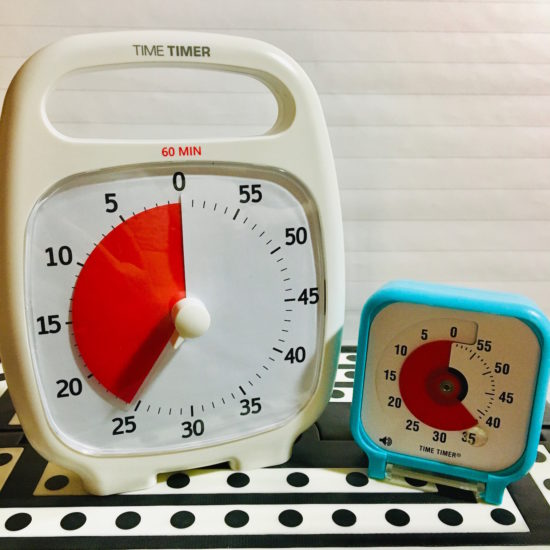
Time Timers aren’t just clocks. They have three important features:
- They’re analog. Most clocks and timers these days are digital, and for a lot of people, digital time is pretty amorphous. 11:12 and 12:11 don’t feel appreciably different.
- They’re visual. Digital clocks don’t show you the passage of time, they just show you numbers. You can ask Siri or Alexa to tell you when 45 minutes are up, but depending on where you are in the flow state, not really sensing the passage of time can lead to anxiety. But all of the Time Timer products (including the Original, the Plus, the Mod (my favorite!), the watches, and the apps) have a colored disc that shows the passage of time so you or your kids can have a more sensory experience and see time passing.
- They’re not distracting. You don’t hear Time Timers tick like most analog clocks or timers. There’s an optional audio alert when time is up, but otherwise, there’s nothing to steal your focus.
There are many different ways to corral the benefits of analog clocks, especially the Time Timer, into your back-to-school process. For example:
Busy parents are trying to get their kids up, get themselves put together, make sure some kind of breakfast is attempted, pack lunches, sign permission slips, and get everyone out the door. That’s a lot to do, and mornings can be a slog. Setting up a colorful Mod in the high-traffic kitchen keeps everyone’s eyes on the prize.
Got tiny humans who take way too long on morning grooming, meaning that making the bus is an iffy proposition? Setting the Time Timer PLUS 20 Minute on the bathroom counter will let them see that washing the breakfast off their faces, brushing their teeth, combing their hair, and getting dressed need to be accomplished in a bit more orderly fashion and look…that’s another five minutes or more of the red disc disappearing! It’s helpful at both ends of the day, because an orderly bedtime ritual (with a combo dry-erase board and TimeTimer) can make mornings flow better, too.
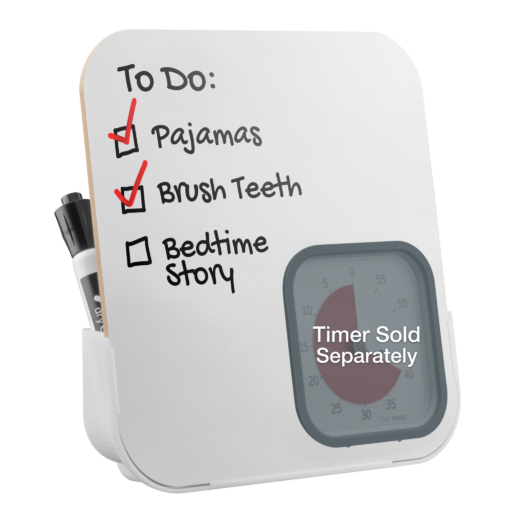
Note: I’m not sure what kind of societal norm we’ve developed to keep clocks out of bathrooms, but Paper Doll is coming out firmly against that. As someone who has occasionally been known to hold a book in my left hand while lackadaisically holding the hair dryer in my right hand, I think an analog clock, particularly a Time Timer, belongs in the corner of any bathroom countertop to keep our attention where it belongs. (Speaking of bathrooms, last November, when we were in the thick of the pandemic, I wrote Organize Your Health: Parental Wisdom, Innovation, and the New Time Timer® Wash. Given Delta, Delta+, Lambda, and whatever Greek letters might come our way, it’s worth revisiting.)
Are your older students (in high school and college) going to be taking standardized tests this year? SATs? ACTs? GREs? LSATs? M-I-C-K-E-Y-M-O-U-S-Es! (Sorry. Got carried away for a minute.) These timers are ideal for practicing timed sections of those exams.
And, of course, Time Timers are a great way for high school and college students, as well as office workers, to get (and stay) in the flow when using the Pomodoro Technique, whether you’re using the standard 25 minutes of focus/5 minutes of break method, or a modified 45 minutes of work/10 minutes of break approach.
For more ideas, check out how the Time Timer can be used:
- In education (for students, teachers, and administrators)
- At home
- At work
- In “special needs” circumstances
Academic Planner: A Tool For Time Management®
If you’ve been reading Paper Doll for even a little while, you should be familiar with the Academic Planner: A Tool For Time Management®, the brainchild of my colleague (and fellow Cornell University alumna) Leslie Josel of Order Out of Chaos. Last year, when Leslie’s latest book launched, I interviewed her for Paper Doll Peeks Behind the Curtain with Superstar Coach, Author & Speaker Leslie Josel.
Back in ye olden days (that is, when Paper Doll went to school), middle and high school students didn’t generally have planners. The more organized of us had top-bound spiral notebooks, as though we were junior reporters (or youthful spies) and we used them as assignment notebooks. Teachers recommended faithfully copying down each assignment before leaving the classroom. If these instructions were followed, you’d get home at the end of the day with a page or two of clear notes of what pages you had to read, what problem sets you had to complete, and what essays needed to be written.
Unfortunately, assignment notebooks are like to-do lists. They tell you what to do and when it needs to be finished, but provide no context. (Maybe students should read my post from last month, Checklists, Gantt Charts, and Kanban Boards — Organize Your Tasks?)
So, somewhere in the 1990s, middle and high schools started giving out school-themed paper planners for students to track their projects. It was an improvement, just like planners adults used. Those planners gave kids space to write due dates, but no guidance for keeping track of all the granular details of a complex teenage life—not just classes, homework, projects, and exams, but extracurricular activities, part-time jobs, and family obligations!
This is where the Academic Planner: A Tool For Time Management®, a Family Choice Award-winner, comes in. Leslie’s patented calendar layout helps students see their school assignments right along with their after-school activities so they can plan when they have time to get work done and not merely know that they have to get it done.
The planner has a wide variety of features and benefits:
- Instead of having to write course names over and over as assignments come up, the planner has unique subject pages at the front and the back so students only have to record class subjects (for which 7 subject boxes are provided) once! If it’s written once and always there, you can’t forget it!
- The planner has oodles of space to enter all Monday-Friday school/after-school activities from 2 p.m. until 9 p.m. as well as weekend obligations. This makes it easier for students to plan and manage their time and tasks.
- The pages of the planner line up with the grid of classes on a class-by-class basis, so it’s easier for students to record their weekly schedules and review them. (This is a plus for all those schools that use those weird modules so that every week’s schedule is different!)
- The planner lays out the days of the week horizontally across the top of the weekly two-page spread instead of putting half a week, stacked, on either side. This is much more like the kind of layout most adult paper planners use, and the grid format makes it easy to enter and view assignments and due dates.
- Because a weekly view gives a pretty constrained sense of what needs to be accomplished, the planner also has monthly pages and large pages for writing complex assignments and activities.
See it in action:
In addition to the planner itself, there are a variety of downloadable extras, including a project planning guide, a study planning guide, printable academic planning worksheets, and an accessories pack with a page marker, a monthly tab sheet and a sheet of student stickers.
The whole kit-and-caboodle is $19.99. (If you’re in the US, be sure to use the code FREESHIP60 when you check out to get free shipping on all orders above $60.) You can also get a pack of extra stickers and accessories for $10.79, if you’re so inclined.
Personally, I think adults would get more enjoyment out of their paper planners if they felt at ease buying stickers. In a cool stationery store in London in 2019, I bought a packet of stickers with motivational messages and cool graphics, like luggage tags to mark vacation days. Adult coloring books became a self-care powerhouse. Why not stickers?
Paper Doll thinks adults would get more enjoyment out of their paper planners if they felt at ease buying stickers. Adult coloring books became a self-care powerhouse. Why not stickers? Share on XFinally, as we wrap up the “time” section, I want to point out again that Leslie’s book, How to Do It Now Because It’s Not Going Away: An Expert Guide to Getting Stuff Done is top-notch for high school and college students needing support on time management and productivity. It’s one of only two books I recommend when parents ask for organizing advice for their students. The other is Donna Goldberg’s classic, The Organized Student: Teaching Children the Skills for Success in School and Beyond. It’s also superb, but was published in 2005, so unlike Leslie’s book, there are few tech solutions. (It’s also much more geared for tangible organizing vs. Leslie’s, which focuses on tasks, time, and overcoming procrastination.)
SPACE: THE FINAL (and limited) FRONTIER
Last week, in Vibrant and Vertical: Organizing Paper for Back-to-School, we looked at products for helping students of all ages manage their paper. Today, we’re focusing on organizing space, particularly for college students in dorm rooms, where space is in short supply.
Flat-Plug Power Strips and Surge Protectors
If you’ve moved a college student into the dorms, you’ve probably noticed two things about the space. First, it’s at a premium and you can’t afford to waste an inch of it. Second, the room wasn’t designed by professional organizers, which means that it’s not optimally functional.
For example, the built-in heater is right next to the desk, putting the expensive new computer at risk. The short cord for the mini-fridge limits where in the room you can actually put it. And the electrical outlets are all behind desks and beds, so a traditional extension cord plug needs up to two inches of space to accommodate the plug head!
Aha! But did you know there are power strips and surge protectors with flat-head plugs, so instead of poking straight out, they extend to the side, taking up minimal room, allowing furniture to sit, if not flush against the wall, much closer?
I like this tiny Anker Power Strip with USB PowerExtend. Not only is it designed with a flat plug, it has a 5-foot extension cord, two outlets, and two USB ports.

At only 3.3″ long and 1.8″ thick, this isn’t going to power everything in the room, but it’s ideal for bed-side or desk-top items you need to charge, and at $12.74 from Amazon, it’s an inexpensive solution to the “I can’t plug it in!” frustration.
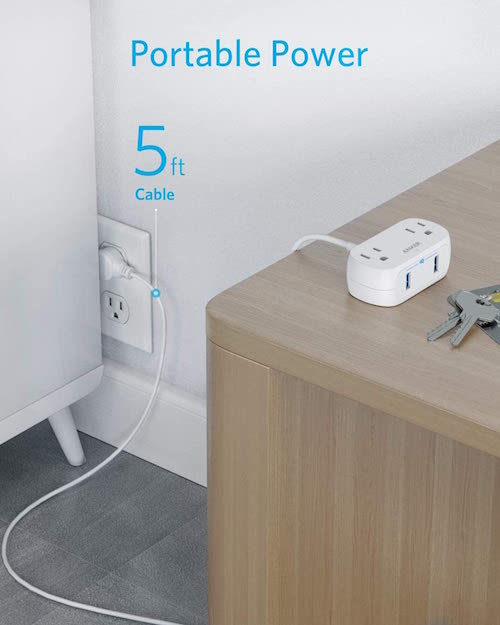
The Anker Power Strip comes in black or white, and in 5′, 8′, and 10′ lengths, but for some reason, the black versions are more expensive than the white ones at every length.
If you want an actual surge protector and one that accommodates charging multiple devices, there are a variety of options. I like the style and functionality of this Tessan Power Strip Surge Protector.
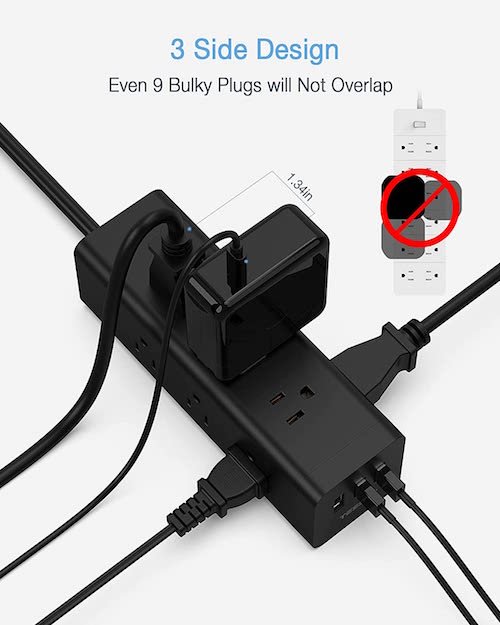 In addition to the flat plug, it has nine AC outlets and 3 USB ports, and a 6.5′ cord. But what appeals to me in particular is the functionality of the design in how the outlets and ports are laid out, with three outlets on the two sides and top of the surge protector, and the three USB ports on the small front end. By not squishing everything on the top surface, there’s more room to use those occasional oversized charging plugs. It’s $19.00, and in the reverse of Anker’s odd pricing, the white version is more expensive, at $24.99.
In addition to the flat plug, it has nine AC outlets and 3 USB ports, and a 6.5′ cord. But what appeals to me in particular is the functionality of the design in how the outlets and ports are laid out, with three outlets on the two sides and top of the surge protector, and the three USB ports on the small front end. By not squishing everything on the top surface, there’s more room to use those occasional oversized charging plugs. It’s $19.00, and in the reverse of Anker’s odd pricing, the white version is more expensive, at $24.99.
USB-USB-C Adapters
I recently purchased one of the gorgeous new 24″ iMacs. When I got it, I was so focused on the front:

that I didn’t really pay that much attention to the specs or the photo of the rear view:
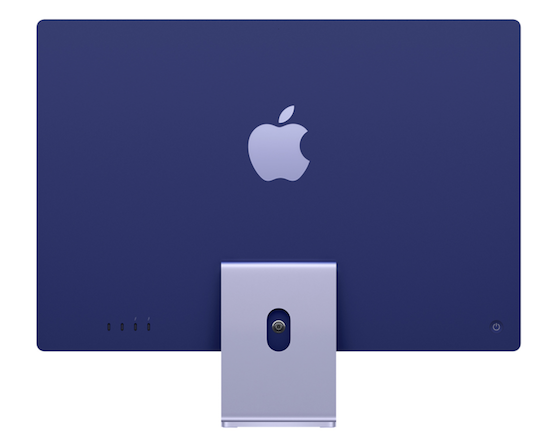
If you’re an old-time iMac user, you may (or may not) peek at the lower left corner of the rear of the computer and see the problem. You see, on my old iMac, I had four USB ports, two Thunderbolt ports, and an ethernet port. On the new iMac, I have just two itty-bitty, teeny-weeny USB-C ports and two ittier-bittier Thunderbolt 3 ports.
The problem? Computers don’t come with CD drives anymore, so I have an external one with a USB connection. And I have a 2TB external hard drive for backing up locally, also with a USB connection. I have a USB Fitbit charger, a little USB fan for hot days, and a USB podcast-quality external microphone. And now none of them fit my new computer!
Now, this isn’t a tragedy. I use an old-timey Space Bar monitor riser with two front-facing and three rear-facing USB ports, and two front-facing USB charging-only ports, and I just need to plug the new iMac into the old riser. But during the transition, I really need something to make everything fit in a tiny, tidy way. (And the Space Bar monitor riser is ancient, so I can’t count on it forever.)
So, if you’ve got a high school student or college student with a new computer and a lot of (slightly) older devices and chargers, you don’t need to rush to purchase a desktop space-hogging USB hub adapter. Instead, get a sense of how much your student needs to modify the space part of the space-time continuum.
There are miniature adapters, sans cables, you can plug in to the USB-C ports of your new devices and plug your older USB items into them. I purchased a Syntech USB C to USB Adapter 2-pack in Rose Gold (to coordinate with the purple iMac, of course) for $10.99.

Instead of shelling out for a big hub that I probably don’t need, for a little more than $5 each, these little 1.08″ long x 0.65″ wide x 0.32″ high doohickeys save space and minimize the number of cables in my space.
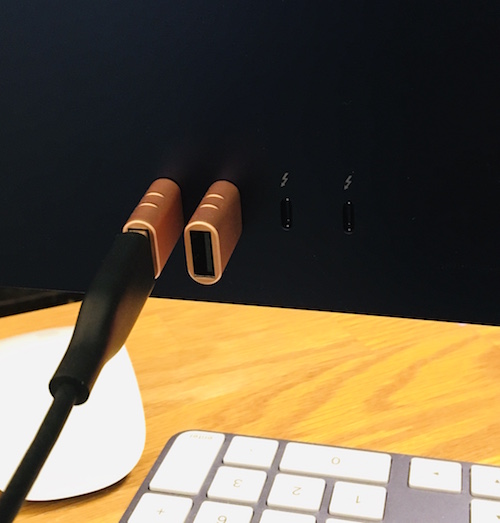
If you’ve got a dorm-based student, looking for space-saving items for electronics, check out the wide variety of tiny USB-to-USB C options.
I hope you and your families have a great school year. Good luck taking up your share of the space-time continuum!
Disclosure: Some of the links above are affiliate links, and I may get a small remuneration (at no additional cost to you) if you make a purchase after clicking through to the resulting pages. The opinions, as always, are my own. (Seriously, who else would claim them?) For more information regarding how Best Results Organizing handles affiliate links, please see the affiliate section of the site’s Privacy Policy.
Organize Your Life: The Truth About Resolutions, Goals, Habits, and Words of the Year
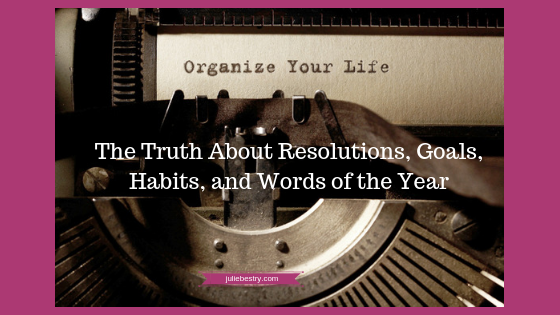
A new year begins and we give ourselves absolution for everything that has happened previously: our diets, our habits, our clutter. We have this vision that the true version of us isn’t reflected by everything we’ve ever been, but who we could become. Whether that mindset is more a matter of naiveté or positivity doesn’t matter as much as figuring out how we can transform this vision of who we want to be into a reality where we can say, this is who we truly are. So how do we get there?
RESOLUTIONS
New Year’s resolutions tend to come in two flavors. We promise ourselves we will change some behavior or personal trait (quit smoking, swear less, be nicer to our mothers, etc.) or accomplish some personal goal (run a 5K, learn Italian, knit a sweater). Making resolutions dates back ancient times. For example, the Babylonians apparently promised the gods they would return borrowed objects and repay debts. (Perhaps that resolution came from having achieved the prior year’s resolution to declutter, during which they found all the things they’d borrowed?)
In the United States, the ritual of making resolutions has actually increased over time, from about 25% of the population to over 40%. The biggest advantage I see in making resolutions is that it allows us to start the new year in a motivated, positive way – generally, at a time when the weather, our weights, our checking accounts, and our moods are fairly frightful. The disadvantage, however, is that most of us abandon our resolutions somewhere between February and June.
Resolutions tend to fizzle because of a few reasons: the real world (that is, the same things that kept us from maintaining our resolve last year) gets in the way, we haven’t identified working strategies for achieving our resolutions, or we have resolved to do something because we think we should rather than because we really want to do it.
If you’d like some inspiration for developing new or different resolutions, the Daring to Live Fully blog offers 29 New Year’s Resolution Ideas that go beyond the typical, with some motivational notions for volunteering, being more conscientious, and bringing more peace into your life. Lifehack has 50 New Year’s Resolution Ideas and How To Achieve Each of Them to help get you started. From adopting a pet to getting over an ex, there are enough choices to help you make this next year a little more interesting.
GOALS AND HABITS
Goals are the less shiny versions of resolutions. Nobody announces “New Year’s Goals” with a flourish or breathlessly asks celebrities about their “New Year’s Habits.” But goals provide a big-picture framework, and habits develop the muscles to accomplish those goals.
SMART goals are popular because they identify where resolutions and plans have might otherwise fail without precautions. SMART goals are supposed to be:
- Specific (What are you going to do? Use action verbs!)
- Measurable (What metrics will you use to show you’ve done what you said you’d do?)
- Achievable (Is this a practical goal? Is it realistic?)
- Relevant (Does this goal make sense for your life, family, or business?)
- Time-based (When will you start? When will you do the action? When will you repeat it? When will you finish? Remember, “Someday” is not a day on the calendar!)
You may want to lose weight, pay off debt, find a significant other, or grow your business, but the way to get there can’t be vague. Make sure your goals spell out what you’re going to do, how you’re going to do it, and how you’re going to measure your success.
Goals set the rules and create the game plan, but habits are how you get to the finish line. The reason you lose your keys all the time is because you don’t have a habit of always putting your keys in the same place every time you come home. (Or, I guess, you’ve got a hole in your pocket.)
Habits are settled or repeated tendencies. Bad habits become like second nature (which makes them hard to break). Luckily, good habits are hard to break, too! That means that if you can get in the habit, so to speak, repeating positive, healthy tasks, you stand a much better chance of achieving your goals.
Two superior resources for understanding how habits work, and how you can put them to use in your life, are:









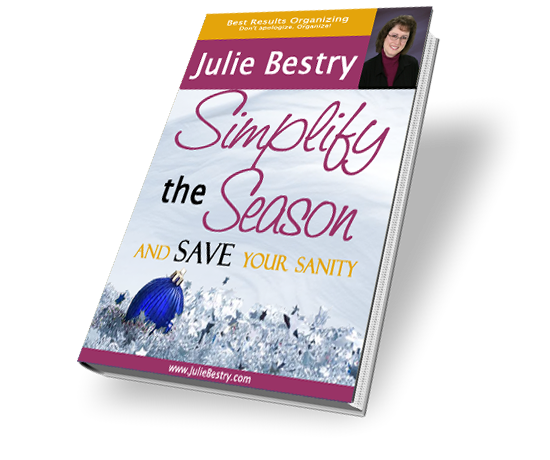




Follow Me